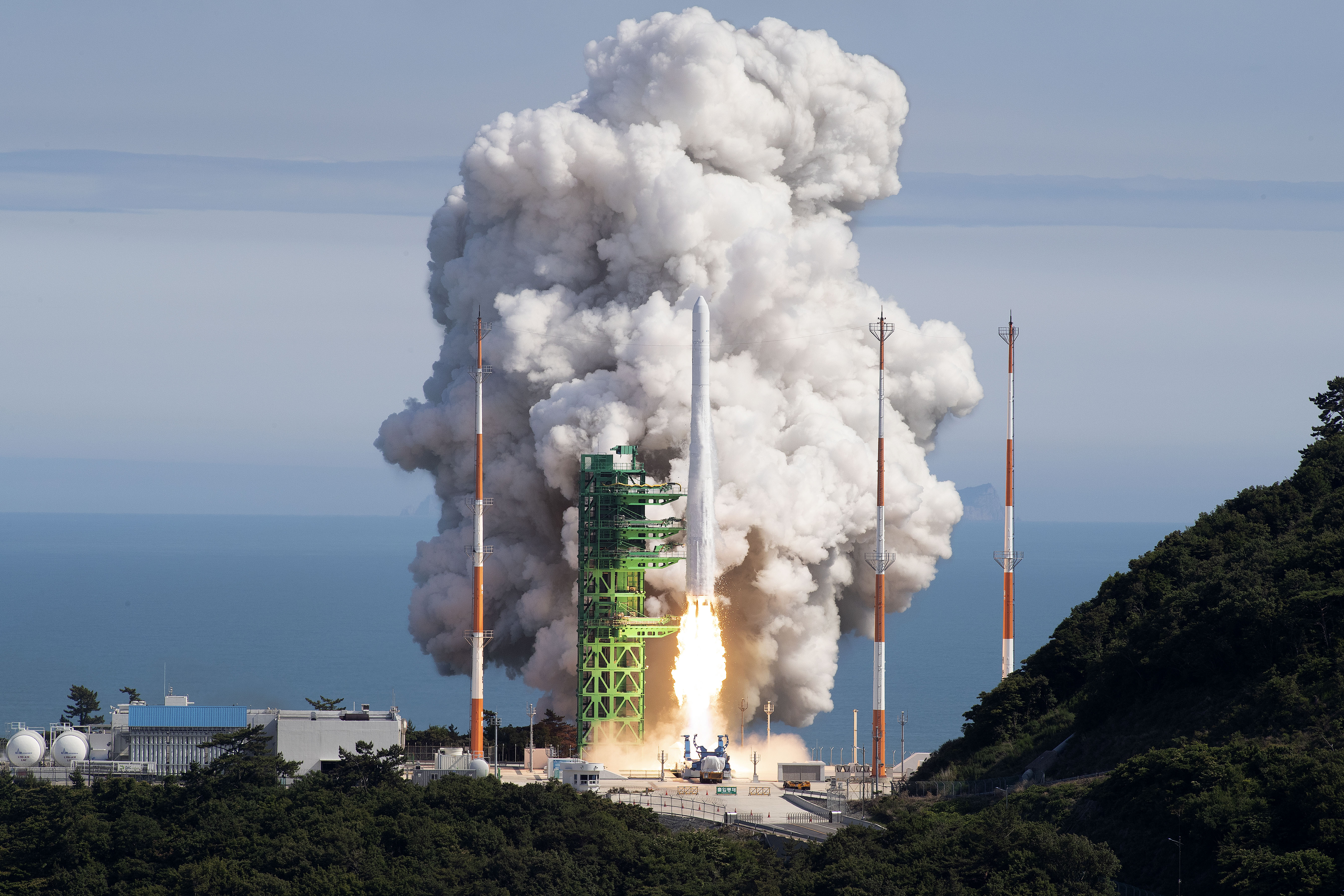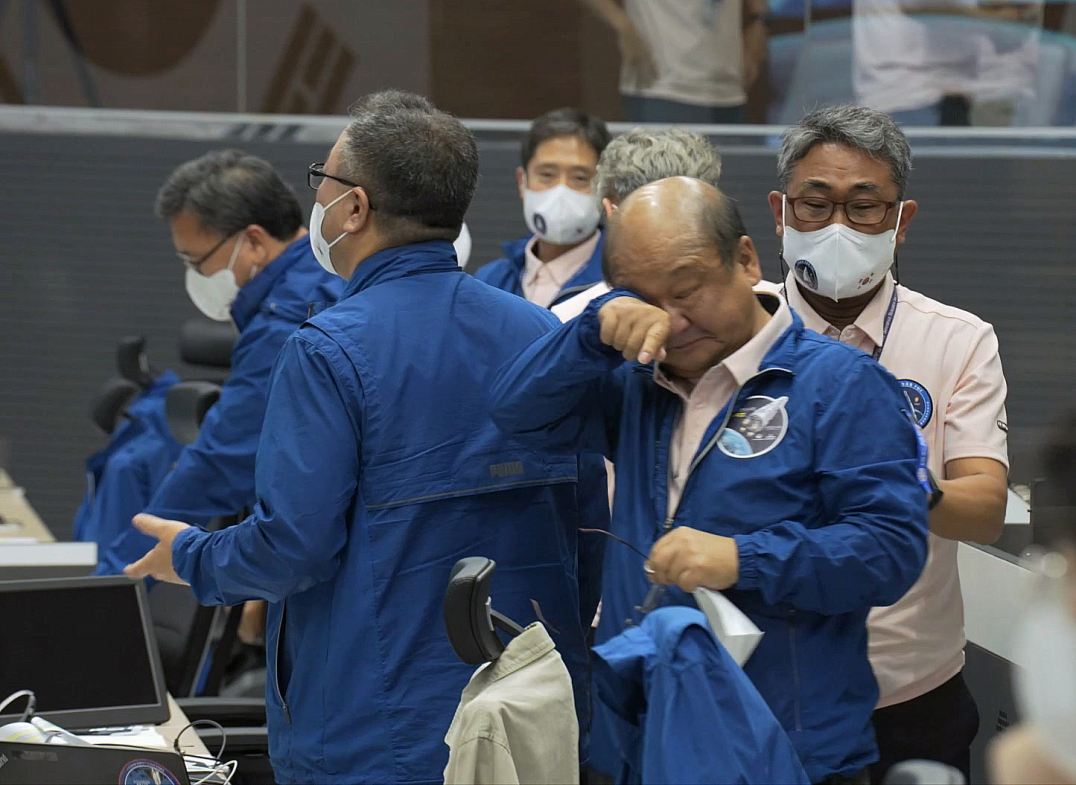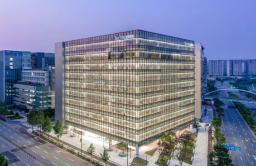-
KOSPI 2577.27 -2.21 -0.09%
-
KOSDAQ 722.52 -7.07 -0.97%
-
KOSPI200 341.49 +0.02 +0.01%
-
USD/KRW 1396 -2.00 0.14%
S.Korea ushers in new space era with rocket launch success

Aerospace & Defense
S.Korea ushers in new space era with rocket launch success
Nuri successfully lifts off and deploys satellites into orbit; President Yoon vows to establish government body to support aerospace industry
By
Jun 21, 2022 (Gmt+09:00)

GOHEUNG, South Korea -- South Korea opened a new space era as it succeeded in the launch of a homegrown space rocket carrying payloads to become the world’s seventh country with advanced aerospace technology capable of sending at least a 1-ton satellite into orbit.
The Korean Satellite Launch Vehicle Two (KSLV-II), nicknamed Nuri, meaning the world in Korean, lifted off at 4 p.m. local time on Tuesday as scheduled from the Naro Space Center in Goheung, 473 km south of Seoul.
Nuri successfully completed its flight sequence and deployed satellites at the target altitude of 700 kilometers above the Earth within 13 minutes of the launch.
“The path from South Korea’s land to space has been opened,” said President Yoon Suk-yeol, celebrating its successful launch. Yoon also pledged to set up a government body to support the country’s aerospace industry.
Nuri’s success escalated South Korea’s status to become one of the world’s seven space powerhouses including the US, Russia, China, Japan, the European Union and India, which have launched satellites of at least 1 ton with their own technology.
North Korea, Israel and Iran are capable of sending domestically developed satellites but only those weighing less than 300 kilograms.
“South Korea’s science and technology has made a great step forward,” said Minister of Science and ICT Lee Jong-ho.
The country succeeded in putting satellites into orbit on the second attempt. Nuri carried a demonstration satellite and four cube satellites. In October last year, it launched Nuri but failed to put a satellite into orbit.
COOPERATION OF 300 SOUTH KOREAN COMPANIES
The science ministry and the state-run Korea Aerospace Research Institute (KARI) have been developing a homegrown projectile to put a 1.5-ton satellite into orbit 600 km to 800 km above the Earth since 2010 with an investment of 2 trillion won ($1.5 billion).
In the private sector, about 300 local companies joined the project. Hanwha Aerospace Co. developed its engine, while Korea Aerospace Industries Ltd. (KAI) handled the system assembly. Hyundai Heavy Industries Co. built the launch pad and Space Solutions produced the drive system. Hanyang ENG Co. developed various control systems, while Danam Systems Inc. manufactured the electronic payloads.
Major Participating Companies in Nuri Development (Source: KARI)
| Area | Company | |
| System assembly | Korea Aerospace Industry | |
| Engine | Engine assembly | Hanwha Aerospace |
| Turbopump | Hanwha Aerospace, S&H, and others | |
| Combustor/Gas generator | Vitzrotech | |
| Propulsion engine/supply system | Hy-Lok Korea, Neopec, Teba Corporation, and others | |
| Pyro igniter (starter) | Hanwha, Neopec, Samyang Chemical, and others | |
| Measurement system | E&E | |
| Mission | Mission control system | Hanwha Defense and others |
| System integration | Ground control system, piping assembly, etc. | Hanwha, Yukon System, and UREATac |
| Guidance control | Drive system, thruster system, and others | Hanwha, Space Solutions, and others |
| GPS receiver | NAVcours and others | |
| Electronics | Electronic payload | Danam Systems, GigaRF, Syscore, and others |
| Structure | Tank, fuselage, and others | S&K Aerospace, Innocom, Doowon Heavy Industries, Hankuk Fiber, DACC Aerospace, Poongsan, and others |
| Heat/Aerodynamic | Heat control/Fire safety | Hanyang ENG and others |
| Ground systems | Launch pad | Hyundai Heavy Industries and others |
| Test equipment | Equipment installation | Hanwha, Hanwha Aerospace, Hyundai Rotem, Hanyang ENG, Vitzrotech, and others |
| Construction/Architecture | Hanjin Heavy Industries, Gyeryong E&C, Dongil E&C, DW Development, Sunjin, and others | |
The country mobilized all the high-tech equipment at the Naro Space Center, as well as tracking centers in Jeju Island and Palau, a country in Oceania, for the launch. The authorities operated radars that can track the rocket’s real-time location within a radius of 3,000 km, and telemetry that can check its flight trajectory and operation up to 2,000 km.
The King Sejong Station, South Korea’s research center in Antarctica, received data sent by satellites in 42 minutes and 23 seconds after Nuri’s launch.
“We have successfully completed the first phase to launch a lunar probe and explore deep space,” said Hwang Jin-young, a senior researcher at the KARI.
Write to Hae-Sung Lee and Jin-Won Kim at ihs@hankyung.com
Jongwoo Cheon edited this article.
More To Read
-
 CryptocurrenciesRedotPay lands in Seoul with crypto cards
CryptocurrenciesRedotPay lands in Seoul with crypto cards20 HOURS AGO
-
23 HOURS AGO
-
 Corporate strategyHankook & Company to set up CVC with $11 mn in funding
Corporate strategyHankook & Company to set up CVC with $11 mn in funding24 HOURS AGO
-
 Electric vehiclesBYD’s Atto 3 overtakes Tesla’s Model Y as best-selling EV in South Korea
Electric vehiclesBYD’s Atto 3 overtakes Tesla’s Model Y as best-selling EV in South KoreaMay 09, 2025 (Gmt+09:00)
-
May 08, 2025 (Gmt+09:00)


